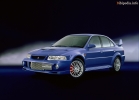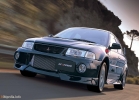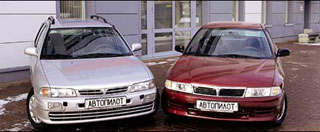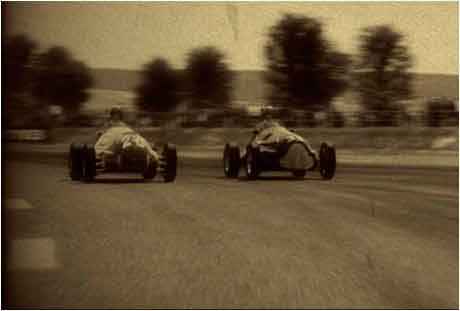Test drive Mitsubishi Lancer Evolution VI 1999 - 2000 sedan
The illusion of omnipotence
According to polls, most readers at the wheel are not averse to purchasing an all -wheel drive station wagon. Unfortunately, there are no domestic cars of this type yet. VAZ 2131 is still a typical alternate, an all -wheel drive ten is exotic. And therefore, imported participants in the test were determined by the well -known formula by the number more, cheaper price.Similar and different
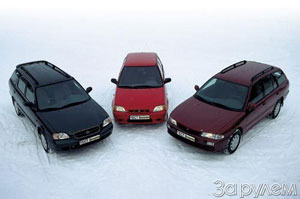 Each of the three cars has its own genealogy, and sometimes quite long: Mitsubishi Lancer - a car of the former generation, produced since 1992, Subaru -jam has the same body that Suzuki has a debut that made it up in 1983, and only Suzuki Baleno appeared In 1995, and the appearance of the 1999 model of the model year, presented for the test, was updated several months ago. Therefore, it is not surprising that in their design there are clearly outdated elements: a dependent suspension of the rear drive wheels on Mitsubishi, the central injection on Subaru. All cars with a transverse power unit have a drive of four wheels with viscousyft in the transmission. However, its action is different: under normal traffic conditions, it is practically a front -wheel drive car, and the rear wheels are connected only when front slipping. Lancer and Jackie, on the contrary, constantly pass the torque to all four wheels, and the Wish-Muft plays the role of a soft blocking of the center differential. But to how it works, we will return later.
Each of the three cars has its own genealogy, and sometimes quite long: Mitsubishi Lancer - a car of the former generation, produced since 1992, Subaru -jam has the same body that Suzuki has a debut that made it up in 1983, and only Suzuki Baleno appeared In 1995, and the appearance of the 1999 model of the model year, presented for the test, was updated several months ago. Therefore, it is not surprising that in their design there are clearly outdated elements: a dependent suspension of the rear drive wheels on Mitsubishi, the central injection on Subaru. All cars with a transverse power unit have a drive of four wheels with viscousyft in the transmission. However, its action is different: under normal traffic conditions, it is practically a front -wheel drive car, and the rear wheels are connected only when front slipping. Lancer and Jackie, on the contrary, constantly pass the torque to all four wheels, and the Wish-Muft plays the role of a soft blocking of the center differential. But to how it works, we will return later. Geometry lessons
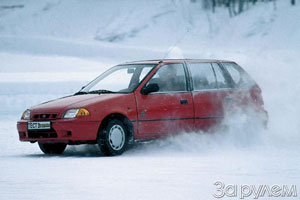 If Suzuki and Mitsubishi are, without stretching, classmates, then Subaru -jacket is a car much smaller: about half a meter shorter and 100 mm already. Despite this, it is little inferior in length of the cabin to large cars, and loses in the size of a rather modest luggage compartment: almost 500 mm shorter and 100 mm lower than that of Mitsubishi. In addition, he has the smallest opening of the rear door and the highest floor. The horizontal arrangement of the spurt under the floor of the luggage compartment is characteristic of all machines, but on Mitsubishi it is placed outside, as on Moskvich-2141 or Peugeot, and in Suzuki between the rug and the reserve a whole shelf with pockets and even a plastic bucket inside the wheel is hidden. Nevertheless, the trunk of Baleno is objectively the largest, although the distance between the niches of the rear wheels is less here than that of Lancer.
If Suzuki and Mitsubishi are, without stretching, classmates, then Subaru -jacket is a car much smaller: about half a meter shorter and 100 mm already. Despite this, it is little inferior in length of the cabin to large cars, and loses in the size of a rather modest luggage compartment: almost 500 mm shorter and 100 mm lower than that of Mitsubishi. In addition, he has the smallest opening of the rear door and the highest floor. The horizontal arrangement of the spurt under the floor of the luggage compartment is characteristic of all machines, but on Mitsubishi it is placed outside, as on Moskvich-2141 or Peugeot, and in Suzuki between the rug and the reserve a whole shelf with pockets and even a plastic bucket inside the wheel is hidden. Nevertheless, the trunk of Baleno is objectively the largest, although the distance between the niches of the rear wheels is less here than that of Lancer. At first glance, the Mitsubishi salon is more spacious than that of Suzuki, but in reality it is only wider. If on his front seats people are swaying taller than 180 cm, the knees of the rear passengers will have to be cramped. Even a little Subaru will give them more space - however, it is not easy to squeeze into the rear seat through modest sizes.
 It is even more surprising that with a noticeably narrower salon, passengers of Suzuki Baleno feel more freedom than in Mitsubishi. The fact is that in Suzuki the seats are closer to the door, and therefore the driver is further from the passenger. The recesses in the doorway allow you to twist the steering wheel, without fear of the left elbow. Mitsubishi leads the height of the salon, but there are enough places over the head of the driver in all cars. Only the small Subaru is low in the back of the cabin, but in comparison, for example, with VAZ 2109 there is noticeably more spacious.
It is even more surprising that with a noticeably narrower salon, passengers of Suzuki Baleno feel more freedom than in Mitsubishi. The fact is that in Suzuki the seats are closer to the door, and therefore the driver is further from the passenger. The recesses in the doorway allow you to twist the steering wheel, without fear of the left elbow. Mitsubishi leads the height of the salon, but there are enough places over the head of the driver in all cars. Only the small Subaru is low in the back of the cabin, but in comparison, for example, with VAZ 2109 there is noticeably more spacious. However, the size of the salon does not always determine the convenience of the driver's seat. Lancer offers a high landing, a convenient seized steering wheel and good visibility. Baleno does not combine the command seat with a low -located, almost vertical steering wheel. Even adjusting the seat - down the steering wheel - up is not optimal for the driver of medium or high stature, and the steering wheel interferes with landing. In the jet, the opposite is true: the seat is low in sporting, and the steering wheel is high and greatly tilted, so the driver is better than others here tall above the average. Adjustments in the height of the seat and steering to Subaru are not provided.
To free rein, in pampas
 Where will the all -wheel drive at the road car show itself in the best way, if not on a slippery road? At the end of winter, only two types of coatings were available to us - rolled snow and bare ice. Despite the minimum clutch coefficient and universal non -navigated rubber, all cars reached 100 km/h in less than 25 s. Various models of tires do not allow you to make direct comparison, but the most powerful Mitsubishi confidently leaded in every attempt.
Where will the all -wheel drive at the road car show itself in the best way, if not on a slippery road? At the end of winter, only two types of coatings were available to us - rolled snow and bare ice. Despite the minimum clutch coefficient and universal non -navigated rubber, all cars reached 100 km/h in less than 25 s. Various models of tires do not allow you to make direct comparison, but the most powerful Mitsubishi confidently leaded in every attempt. Especially significant for the dynamics were the characteristic of the engine and the selection of gear rates. The highly phoned Mitsubishi engine is maximum torque at 2000 rpm higher than in Suzuki, however, at low speeds, the first turned out to be more burdensome. The modest capabilities of the 1.3-liter eight-valve engine Subaru-jeste partly compensate for short transfers-at the same speed as the rest of the machines, the engine speed is much higher.
Because of this, the results of acceleration on a 10 percent rise turned out to be very indicative: yielding to Baleno Suzuki 20.5 kW/28 liters. with. In the engine power, Jastya gained 80 km/h 2.2 s faster.
When braking on ice and snow, the first place is at the lightest Subaru: he has the smallest mass and the best adhesions of Michelen-Mcht tires.
Third measurement on the plane
 So we approached the most interesting - handling on a slippery road. Many works on the design of the cars have included that a car with all -wheel drive provides better active security. However, there are some but.
So we approached the most interesting - handling on a slippery road. Many works on the design of the cars have included that a car with all -wheel drive provides better active security. However, there are some but. All three cars were distinguished by an enviable course stability, and a small advantage here is for Baleno Suzuki. Again they were convinced: yes, all -wheel drive cars are really capable of passing turns at greater speed due to the uniform distribution of traction between the drive wheels. But the behavior of cars at the limit is not as unambiguous as in the rear -wheel drive or front -wheel drive. Having three differentials in the transmission, one of which with a variable degree of blocking, the car behaves much more independent, and to predict how exactly the torque will be distributed in a particular case on a real uneven coating is not able to even a highly qualified driver. This unpredictability in the distribution of traction makes the behavior of the car in the limit modes in unprognized, and the transition from insufficient rotation to excessive - unexpected and often untimely.
 Translated into everyday language, this means: the reaction of an all -wheel drive car to exactly the same actions in similar conditions can sometimes be ... the exact opposite. In the process of refinement and testing of machines, coordinating the characteristics of the transmission and suspension, the developers try to protect future drivers from such surprises, but this is possible to varying degrees. In our case, Subaru became the unconditional leader.
Translated into everyday language, this means: the reaction of an all -wheel drive car to exactly the same actions in similar conditions can sometimes be ... the exact opposite. In the process of refinement and testing of machines, coordinating the characteristics of the transmission and suspension, the developers try to protect future drivers from such surprises, but this is possible to varying degrees. In our case, Subaru became the unconditional leader. A full -wheel drive car provides great control opportunities compared to machines that have a drive to one axis. Look at the television portage from the world championship in rally: at the bend, cars make a complex plane -parallel movement, extinguishing speed in one direction and at the same time gaining in another - this is a kind of third dimension on the plane.
The exact control of the thrust for an all -wheel drive car means even more than the timely rutting correction. Subaru-jams the only one of the three quickly and accurately performed all the driver's teams. It is not surprising that it was he who, with an impressive margin, was the leader in the speed of the route along the mountain road. But the control balance in critical modes was so fragile that even an extra person in the cabin significantly changed the behavior of the car.
Suzuki Baleno showed greater stability in regular modes, but it was difficult to predict on the other side, Mitsubishi Lancer - on the contrary. The results of this are clearly visible in the table.
YOU NEED IT?
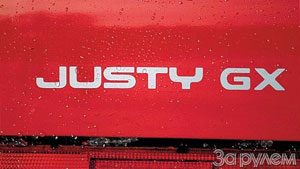 The test results can question the thesis about the greater active safety of the all -wheel drive machine. The full implementation of the increased management possibilities requires the driver significantly better preparation and impeccable coordination of the operation of the steering wheel and gas. This is not easy even for a well -soiled athlete, but there is no need to talk about ordinary mortals. In addition, stability in ordinary modes can play a cruel joke with an inexperienced driver, provoking a slippery road to too fast.
The test results can question the thesis about the greater active safety of the all -wheel drive machine. The full implementation of the increased management possibilities requires the driver significantly better preparation and impeccable coordination of the operation of the steering wheel and gas. This is not easy even for a well -soiled athlete, but there is no need to talk about ordinary mortals. In addition, stability in ordinary modes can play a cruel joke with an inexperienced driver, provoking a slippery road to too fast. It is almost one hundred percent confidence that an unprepared driver is waiting for the loss of a full -wheel drive machine, simulating a typical abnormal situation - a detour of obstacles on a slippery road. Even obedient Subaru is able to give a surprise to a person with stable front -wheel drive, and even more so rear -wheel drive skills.
Instead of conclusions
 But not everything is as bad as we are trying to imagine: after all, the speeds at which troubles are possible will be much higher - the prudent driver will be worried to enter the turn so quickly. In addition, on roads with a higher clutch coefficient than rolled snow (say, on wet asphalt), a breakdown is practically excluded when slipping of the wheels.
But not everything is as bad as we are trying to imagine: after all, the speeds at which troubles are possible will be much higher - the prudent driver will be worried to enter the turn so quickly. In addition, on roads with a higher clutch coefficient than rolled snow (say, on wet asphalt), a breakdown is practically excluded when slipping of the wheels. The all -wheel drive has many advantages, the main thing of which is that the drivers account for the entire mass of the car, and not about half. Therefore, the possibilities for overcoming, for example, slippery lifts are twice as high as with one pair of leading wheels. A higher all -wheel drive and off -road qualities are higher, but it should not be confused with UAZ. Full -wheel drive is a serious argument, but no less important is the supply under the belly and evil rubber. And although the road clearance of all three cars is quite large in terms of foreign standards - from 155 mm in Subaru to 185 mm in Mitsubishi - they are not created for crossed terrain. Even a special modification of the Subaru-jealous Scout with an invalue increased up to 205 mm (!) Rock on the off-road can not be compared, for example, with the Niva.
Suzuki Baleno
Subaru-jistas
Mitsubishi Lancer
Subaru-jista resume
 A wonderful simulator to learn how to drive an all -wheel drive car in an extreme situation; A practical car for a small family.
A wonderful simulator to learn how to drive an all -wheel drive car in an extreme situation; A practical car for a small family. + Outstanding controllability in emergency modes, an economical engine, well -chosen gear rates, an accurate gear shift mechanism, excellent visibility, spacious for a car of this class, good comfort and high energy intensity
- A small trunk, an obsolete appearance, a modest decoration of the salon, seats with weak lateral support, a small gas tank.
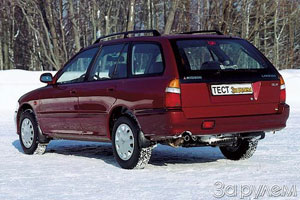 Suzuki-Bano Vagon resume
Suzuki-Bano Vagon resume A lot of modern car for its money, but no less roughness than advantages.
+ Attractive price, spacious interior, large trunk, economical motor, high stability in standard modes, effective heating of the cabin, rich standard equipment.
- Noisy salon, non -optimal ergonomics of the driver's place, a rigid suspension without a stock of energy intensity, noisy ventilation, the motor is weak on the bottom.
Mitsubishi-Lenser Stayishn Vagon resume
The old Lancer will not spoil the furrows: the trumpet voice of the motor calls for the battle, and the suspension will not allow to fall asleep. An honest car, which you can get seriously and for a long time.
+A powerful engine, excellent assembly quality, predicted behavior in emergency modes, low noise, large road clearance, energy -intensive suspension, developed ventilation of the salon.
- mediocre smoothness, high price, brushes do not reach the left rack.
Cars for the test are provided:
Subaru -jasts - the company of Avtotranskomplek,
Suzuki Baleno - Nippon Kars, Mitsubishi Lancer - Rolf Holding.



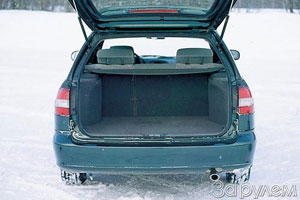
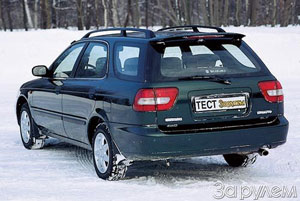
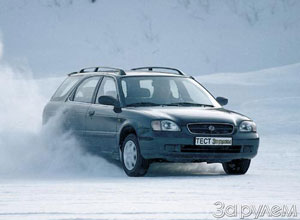


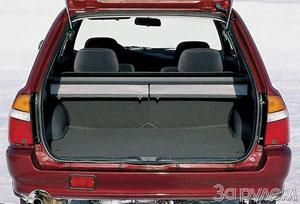






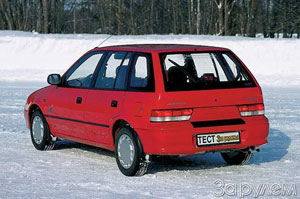
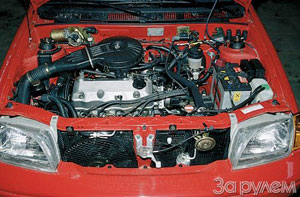
Anatoly Fomin, Anatoly Karpenkov. Photo by Sergey Ivanov
A source: The magazine "Driving"

